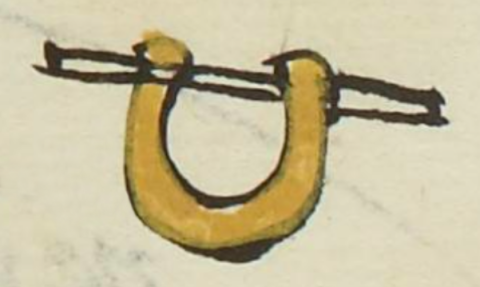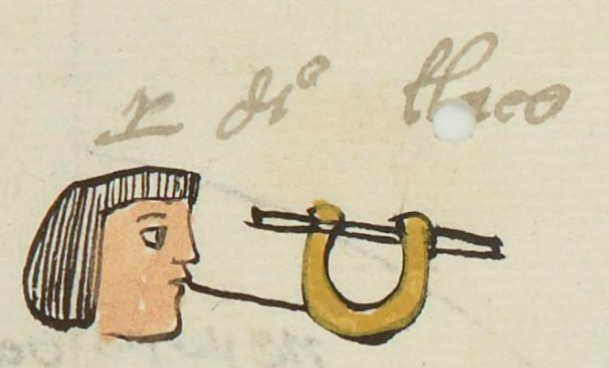Tlaco (MH516r)
This simplex glyph for the personal name Tlaco (here, attested as a man's) shows a U-shaped hoop and a horizontal stick (tlacotl) that would be put around the neck of an enslaved person (tlacotli). The man in question could be an enslaved person. Perhaps more likely, this is a middle child, "Tlaco," and the visual is a phonetic indicator.
Stephanie Wood
John Frederick Schwaller explains (The Church in Colonial Latin America, 2000, 88) how Tiacapan was often the name of the oldest child, Tlaco the name of the middle child, and Xoco the youngest. While Tlaco is more commonly known for girls, Alonso Zamora suggests "Middle Brother" for a reading of this glyph in his blog Tlacuilolli. The stick that is part of the restraint that was put around the neck of an enslaved person can be a tlacotl, the slave a tlacotli, and the half-circle of the throat constrictor could be seen as (tlaco) (half, which is close to the meaning of middle). So, the glyph is at least partly phonographic.
Stephanie Wood
duo .tlaco
Diego Tlaco
Stephanie Wood
1560
Jeff Haskett-Wood and Stephanie Wood
esclavitud, slavery, esclavo, persona esclavizada, niño del medio, nombres de hombres

tlaco(tli) an enslaved person, https://nahuatl.wired-humanities.org/content/tlacotli
tlaco(tl), stick, https://nahuatl.wired-humanities.org/content/tlacotl
tlaco, half, middle, https://nahuatl.wired-humanities.org/content/tlaco
Esclavo
Stephanie Wood
Matrícula de Huexotzinco, folio 516r, World Digital Library, https://www.loc.gov/resource/gdcwdl.wdl_15282/?sp=111&st=image
This manuscript is hosted by the Library of Congress and the World Digital Library; used here with the Creative Commons, “Attribution-NonCommercial-ShareAlike 3.0 License” (CC-BY-NC-SAq 3.0).







